 Colorifix/Pangaia
Colorifix/PangaiaThe price of clothes is more than the pound sign written on the tag, and fashion is said to be responsible for the world’s carbon footprint and garbage.
But businesses and charities in the East of England are urging people to look for solutions in the meantime Sustainable Fashion Week – whether it’s reusable school uniforms, non-toxic paint, or cleaning power.
Decorating clothes is a smart science
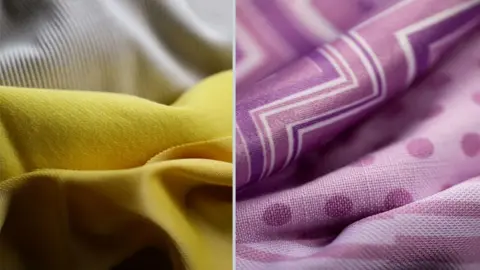 Colorifix
ColorifixA group of Cambridge scientists include H&M and Pangaea among their customers when they came up with a smart way to dye fabric that does not rely on toxic chemicals.
Colorifix, now headquartered in Norwich, bioengineers microbes to create different colors and process them on fabric.
CEO Orr Yarkoni explained: “We find colors in nature, and instead of extracting pigment, we borrow more from the way it’s made – we find the code.
“The code is placed in the microorganism, which is fed sugar and nitrogen and turns it into pigment or paint.”
He said the process reduces water, electricity, pollution and carbon emissions compared to conventional paint, which has “dangerous” effects.
“You’re taking a lot of chemicals and boiling them in a toxic soup. Most of the chemicals used are irreversible – so once in the water, you can’t get them out,” said Mr. Yarkoni.
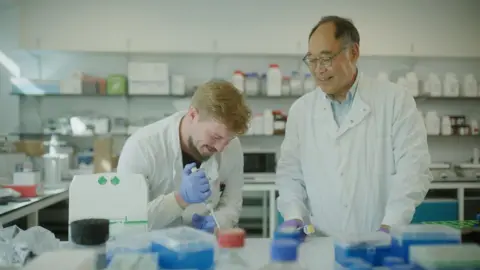 Colorifix
ColorifixHe was inspired to find an alternative after seeing toxic waste in the rivers of Kathmandu and co-founded Colorifix with James Ajioka and David Nugent in 2016.
The company supplies colored fabrics to mills in Italy, Portugal, Brazil and India that supply colored clothing. Yarkoni hopes to be able to match or beat the cost of conventional paint in the future, as he “expands” production.
“Not that we’re working anywhere, but the technology,” he said.
He said his system could help existing industries “move from chemistry to biology”.
“We hope to show brands and manufacturers that can do the same without driving anyone away: you don’t need new paint machines or better controls. You don’t need to start from scratch.
“To be sustainable, you have to be socially and economically sustainable; you don’t want to eliminate jobs or livelihoods,” he added.
The way to burn is the school uniform
 David Luke
David Luke One of the most important rules of sustainable fashion is to make sure that clothes are worn, used, and passed on instead of being hung unworn in the closet or – worse – disposed of properly.
What if an item is too damaged to wear?
By now, most clothes have been recycled, but what if you could turn an old garment into yarn and repurpose it into a new color?
That’s what Project Re:claim hopes to do with school blazers designed by the company David Luke. A polyester recycling plant in Kettering which is run by the Salvation Army is already converting used fabrics into new polyester fibers, in partnership with Project Plan B.
David Luke’s latest blazer has been designed to be 100% recyclable once it’s finished, a process known as the “circular economy”.
Everything had to be rethought, from the lining to the buttons and zippers to the adhesive.
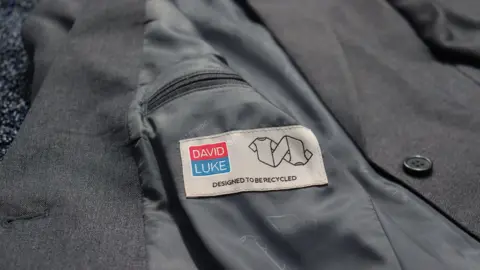 Project Re: get it
Project Re: get itThe CEO of Project Plan B and the Circular Textiles Foundation Tim Cross said: “We now have the ability to help David Luke’s blazers be restored without taking the garment apart, making it completely recyclable.”
In fact, the blazer is considered so iconic that it went on display at the Design Museum in London, alongside the works of fashion designers Stella McCartney and Priya Ahluwalia.
It is shown as part of “Tomorrow’s Clothes”.
Majonne Frost, head of environment and sustainability at the Salvation Army Trading Company, said: “Our idea is to help companies produce uniforms, corporate clothing, fashion clothing and textile brands using recycled polyester.
“This is an opportunity for companies to make a commitment to significantly reduce the environment, and David Luke is showing us how it can be done.”
‘Stilettos to sneakers – we do it all’
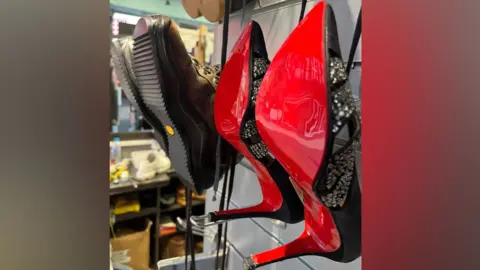 Andy Smith
Andy SmithKeeping shoes on the road and out of the bin is the job of Andy Smith, who set up Shoesmiths in St Albans at the age of 21.
“All kinds of shoes can be repaired and a lot of people don’t know,” said Mr Smith, who has “traveled with the times” to accommodate the various shoe trends.
“When stilettos were in fashion, I was so busy it wasn’t really,” she said.
“Young people are starting to come back to arrange training for them. Passionate runners are running long distances and shoes wear out – they are expensive to replace, so repairing them is a better option.
“It’s a win for your wallet and the world”.
More than 2 million shoes are thrown into landfills every week, according to the charity Shoe Aidso giving them a new life can help a lot.
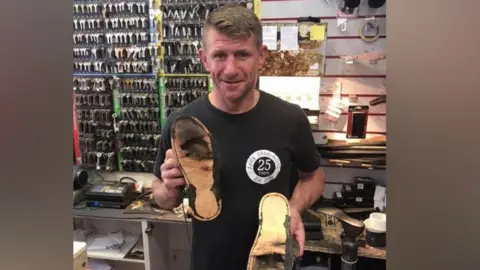 Andy Smith
Andy SmithMr Smith said the busiest time was about 20 years ago, when stilettos were all the rage.
“Everyone joined in – stilettos wear out quickly. I have workers like a chain: one person removes the heel, wipes it, gives it to stick, and another sticks it. on.”
He said he even repairs shoes with molded soles, but he had this tip for anyone looking for easy repair shoes.
“Good quality leather and a contrasting heel is great. Rubber is generally good; plastic is a little rough, but we can handle it.”
He admitted that repairing shoes is seen as “an old-fashioned thing”, but said that young people “are starting to realize that it is a way to help the environment”.
#Sustainable #fashion #win #wallet #planet
